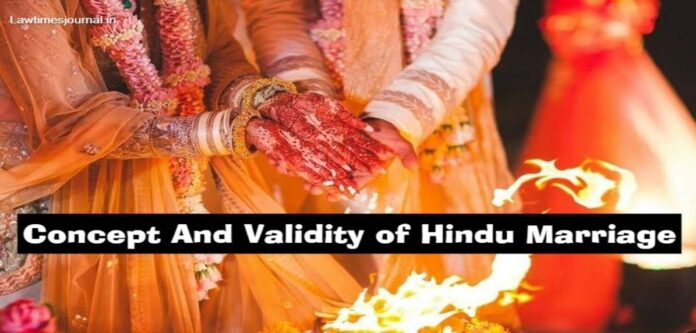"Hindu Marriage: Exploring Concept and Validity."

"Hindu Marriage: Exploring Concept and Validity."
Introduction: Hindu marriage holds a significant place in the socio-cultural and religious fabric of India. It's not merely a union of two individuals but is considered a sacred bond ordained by divine principles. The concept of Hindu marriage is deeply rooted in tradition, religious beliefs, and social norms. In this essay, we'll explore the concept, rituals, and the legal framework governing Hindu marriages, along with their validity. Concept of Hindu Marriage: In Hinduism, marriage is not just a social institution but is deemed a sacrament, a divine covenant between two souls. It is considered a vital aspect of fulfilling one's dharma (duty) and is linked to the broader goals of life - dharma (duty), artha (prosperity), kama (desire), and moksha (liberation). 1. Dharma (Duty): Marriage is viewed as a sacred duty in Hindu society, essential for the continuity of family lineage and tradition. It is considered a moral and social obligation towards one's ancestors and future generations. 2. Artha (Prosperity): Hindu marriage is seen as a means to achieve material prosperity and social stability. It establishes a household conducive to economic growth and ensures the perpetuation of family wealth and heritage. 3. Kama (Desire): Marriage provides a legitimate platform for the fulfillment of physical, emotional, and psychological desires. It allows individuals to experience love, companionship, and intimacy within the confines of societal norms. 4. Moksha (Liberation): Hindu marriage is also regarded as a spiritual partnership aimed at attaining moksha (liberation) from the cycle of birth and death. Through mutual support, devotion, and spiritual growth, married couples seek to evolve spiritually and transcend worldly attachments. The significance of Hindu marriage lies in its role as a cornerstone of societal stability, moral conduct, and spiritual evolution. It is considered a sacred bond that transcends individual desires and connects souls on a higher spiritual plane. Rituals and Customs: Hindu marriage is accompanied by a plethora of rituals and customs, each carrying profound symbolic significance. These rituals vary across regions, communities, and sects, but certain core elements are common to most Hindu weddings: 1. Vivaha Sanskar (Wedding Ceremony): The wedding ceremony, known as Vivaha Sanskar, is the central ritual of Hindu marriage. It involves the exchange of vows, offerings to deities, and recitation of sacred hymns (mantras) by the priest. 2. Kanyadaan (Giving Away of the Bride): In this ritual, the father of the bride formally gives away his daughter to the groom, symbolizing the transfer of responsibility and guardianship. 3. Saptapadi (Seven Steps): The bride and groom take seven symbolic steps together, each step representing a vow and commitment to their marriage. These vows encompass mutual respect, love, fidelity, and support for each other. 4. Mangal Phere (Circling the Sacred Fire): The couple circles the sacred fire (agni) seven times, signifying their eternal bond and commitment to each other. Each circle is accompanied by prayers and blessings from the priest. 5. Sindoor and Mangalsutra: The groom applies sindoor (vermilion) on the bride's forehead and adorns her with a mangalsutra (sacred necklace), symbolizing her married status and the bond between husband and wife. 6. Ashirvad (Blessings): The wedding ceremony concludes with blessings from elders and well-wishers, invoking divine blessings for the couple's prosperity and happiness. These rituals not only sanctify the marriage but also serve to strengthen familial bonds, reinforce cultural traditions, and invoke divine blessings for the couple's future happiness and well-being. Legal Framework: In addition to its religious and cultural significance, Hindu marriage is governed by a legal framework that outlines the rights, duties, and obligations of spouses. The Hindu Marriage Act of 1955 is the primary legislation regulating Hindu marriages in India. Key provisions of the Act include: 1. Conditions for Marriage: The Act lays down conditions for the validity of Hindu marriage, including the age of marriage, mental capacity, absence of prohibited relationships, and monogamy. 2. Registration of Marriage: While registration of marriage is not mandatory, it is advisable for legal recognition and proof of marriage. Registration facilitates the exercise of legal rights related to inheritance, succession, and other matters. 3. Void and Voidable Marriages: The Act specifies circumstances under which a Hindu marriage may be deemed void or voidable, such as bigamy, prohibited degrees of relationship, and incapacity to consent. 4. Rights and Duties of Spouses: The Act defines the rights and duties of spouses in a Hindu marriage, including the right to cohabit, maintenance, and inheritance rights. 5. Divorce and Dissolution: The Act provides for various grounds for divorce, including cruelty, adultery, and desertion. It also allows for judicial separation and provides for the custody, maintenance, and welfare of children. 6. Child Custody and Maintenance: In cases of divorce or separation, the Act empowers the court to make orders regarding the custody, guardianship, and maintenance of minor children. The Hindu Marriage Act, along with other relevant laws and judicial precedents, forms the legal framework within which Hindu marriages are solemnized, regulated, and dissolved. It seeks to balance religious, cultural, and social aspects of marriage with legal protection and redressal of matrimonial disputes. Validity of Hindu Marriage: The validity of a Hindu marriage is determined by compliance with both religious and legal requirements. From a religious perspective, a Hindu marriage is considered valid if it is conducted in accordance with traditional customs, rituals, and scriptures. From a legal standpoint, a Hindu marriage must meet certain conditions laid down by the Hindu Marriage Act for its validity. These include the consent of parties, the legal age of marriage, absence of prohibited relationships, compliance with formalities, and adherence to monogamy. Conclusion: In conclusion, Hindu marriage is not just a union of two individuals but is imbued with spiritual, cultural, and legal significance. It serves as a sacred bond that fosters familial harmony, societal stability, and spiritual growth. By adhering to both religious traditions and legal requirements, Hindu marriage continues to be a cornerstone of Indian society, reflecting its rich cultural heritage and enduring values.